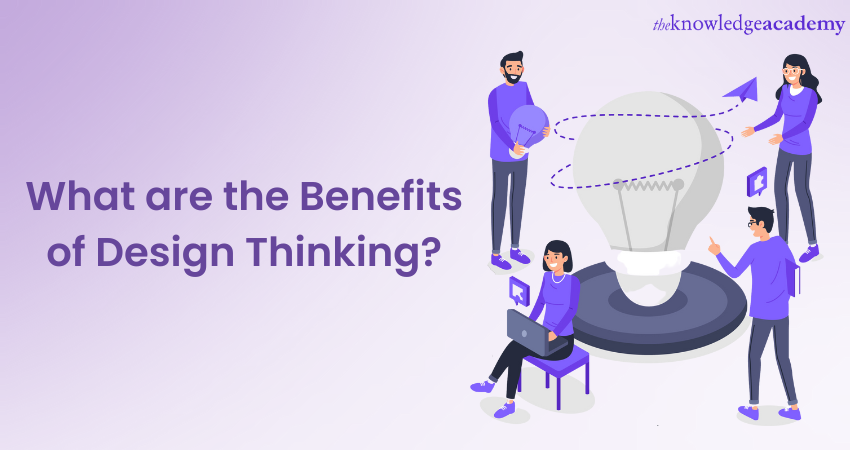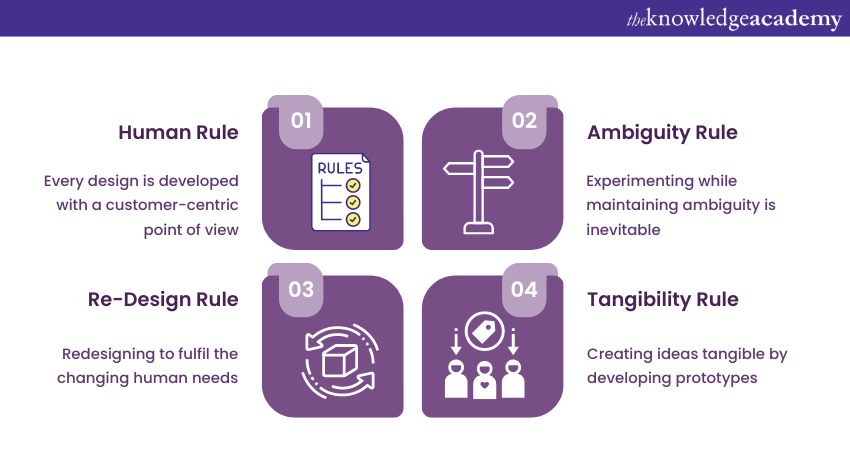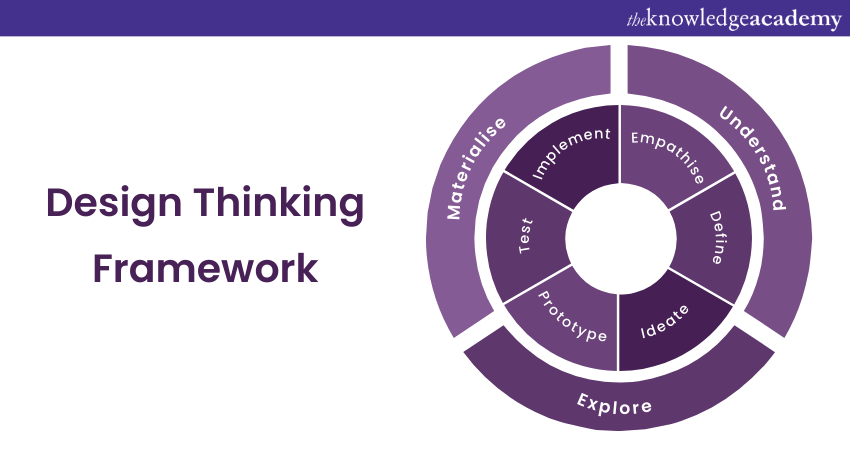We may not have the course you’re looking for. If you enquire or give us a call on +44 1344 203999 and speak to our training experts, we may still be able to help with your training requirements.
Training Outcomes Within Your Budget!
We ensure quality, budget-alignment, and timely delivery by our expert instructors.

Did you know there are several Benefits of Design Thinking that can help you design your brand according to the customer's preferences? Design Thinking is a useful problem-solving methodology that has become increasingly popular recently. It is a process that puts the user at the centre of the design process, focusing on understanding their needs and developing solutions that meet them.
Design Thinking is not limited to design but can be applied to various fields to solve complex problems. Research by IBM found that Design Thinking might lead to productive business results with a 75% boost in efficiency and a 300% increase in return on investment. By employing Design Thinking, organisations can increase innovation capabilities, improve customer experience, and achieve better business outcomes.
In this blog, we will explore the Benefits of Design Thinking and how it can help organisations solve complex problems effectively. Design Thinking is a method for producing creative ideas to solve problems. Read further to learn about Design Thinking benefits you must know to grow your business.
Table of Contents
1) What are the Benefits of Design Thinking?
2) Four principles of Design Thinking
3) How to increase productivity with Design Thinking
4) How does Design Thinking benefit an organisation?
5) Conclusion
What are the Benefits of Design Thinking?
Design Thinking can help improve communication, identify problems, reduce risk, increase innovation, and align solutions with business goals. It can also lead to increased empathy, customer relationships, and employee engagement. Let’s discuss in detail about the Benefits of Design Thinking:
Increased empathy
One of the main principles of Design Thinking is empathy. By understanding the demands and perspectives of users, designers can create truly effective and user-friendly solutions. This can lead to better relationships with customers and increased customer loyalty.
Improved communication
Design Thinking encourages collaboration and communication among team members. By working together, team members can better understand each other's perspectives, share ideas, and work towards a common goal. This can improve communication within the team and lead to better results.
Better problem identification
Design Thinking helps teams to identify the root causes of problems. By focusing on the underlying issues rather than just the symptoms, teams can create solutions that address the core problems rather than just solving them.
Reduced risk
Design Thinking involves prototyping and testing solutions before they are fully implemented. This allows teams to identify potential issues and make improvements before investing significant time and resources. This can reduce the risk of failure and increase the chances of success.
Increased innovation
Design Thinking encourages creativity and innovation. Using various tools and techniques, teams can generate new ideas and develop innovative solutions. This can lead to competitive advantages and new growth opportunities.
Better alignment with business goals
Design Thinking can help teams better align their solutions with the business's goals. By focusing on the needs and wants of customers, teams can create solutions that are more likely to meet the needs of the business and contribute to its success.
Increased employee engagement
Design Thinking encourages collaboration, creativity, and innovation. This can lead to increased engagement and job satisfaction among team members. This can also result in lower turnover rates and higher employee retention.
Four principles of Design Thinking

There are four key principles of Design Thinking. Let’s discuss them in detail:
Human rule
The human rule principle in Design Thinking refers to the idea that the end-users need, wants, and experiences should be at the forefront of the design process. This principle acknowledges that the ultimate purpose of design is to create products, services, and experiences that improve people's lives. Therefore, designers should focus on understanding the end-users needs, behaviours, emotions, and aspirations to create solutions that truly resonate with them.
Human rule involves three key elements:
a) Firstly, empathy is critical to the Design Thinking process. Designers must immerse themselves in the end-user's world to understand their perspectives, experience, and challenges.
b) Secondly, the human rule principle involves a human-centred approach to design. This means that designers should put the end-users at the centre of the design process and create solutions that address their needs and aspirations.
c) Thirdly, the human rule principle requires designers to test and validate their designs by end-users. This involves creating prototypes and conducting user testing to gain feedback and refine the design.
Ambiguity rule
The ambiguity principle in Design Thinking refers to accepting and exploring uncertainty and open-mindedness in the design process. Ambiguity can arise from various sources, such as vague project requirements, conflicting user needs, or unpredictable market conditions. Instead of viewing ambiguity as a problem to be solved, the ambiguity principle embraces it as an opportunity for creativity and innovation.
Re-design rule
The re-design rule in Design Thinking is a process that involves iterating on a design solution multiple times to improve it. This rule is based on the idea that the first solution to a problem is rarely the best and that by continually refining and improving a solution, you can create something truly innovative and effective.
By following the redesign rule, designers can create solutions that are truly innovative and effective, as they are constantly improving upon previous versions of their work. It is an iterative and collaborative process that involves ongoing feedback and refinement, leading to solutions that are well-suited to the needs of users and stakeholders.
Tangibility rule
The tangibility rule in Design Thinking is a principle that emphasises the importance of creating physical and tangible prototypes or models of design solutions. The rule suggests that designing with tangibility in mind can help designers better understand and communicate their ideas, leading to more effective and successful solutions.
How to increase productivity with Design Thinking?

Organisations that incorporate the best design thinking solutions deal with future challenges effectively. Design Thinking helps in figuring out customers’ needs and demands. Design Thinking methodology can be used to increase productivity and drive innovation within a company.
To use Design Thinking effectively, starting with a clear problem statement is important. Further, to ensure that the solutions are effective, you must encourage a diverse team of people with different backgrounds, skills, and experiences to participate in the process. Collaboration is key; an open, respectful, and communicative environment will help the team work together effectively.
Prototyping and iteration are also essential, and low-fidelity prototypes should be created quickly and refined based on feedback. Additionally, empathy is a key component of Design Thinking, as it helps understand the user's requirements and behaviours to create truly user-centred solutions.
Finally, measuring results and using data to evaluate the success of solutions is important to ensure enhanced productivity and the development of innovative solutions. By following these steps, companies can use Design Thinking to solve complex problems and increase productivity.
How does Design Thinking benefit an organisation?
Design Thinking can benefit an organisation in several ways. Firstly, it can help the organisation become more customer-centric by focusing on the demands and requirements of the customers. This can lead to better products and services that meet customer expectations, increasing customer experience.
Secondly, it can foster innovation by encouraging creativity and experimentation, leading to the development of new products and services. Thirdly, Design Thinking can encourage collaboration and teamwork among cross-functional teams, resulting in more effective problem-solving and better outcomes.
Further, it can promote empathy by encouraging organisations to understand users' needs and experiences, leading to more meaningful and impactful solutions. Finally, the iterative nature of Design Thinking means that organisations can continuously refine their solutions based on feedback, resulting in better outcomes and improved performance over time. These benefits can increase customer satisfaction, better business outcomes, and a more engaged and motivated workforce.
Conclusion
Design Thinking helps in exploring possibilities and developing empathy for your target consumers. It is not restricted to just designers but also expands to other professionals who use Design Thinking methodology at every career stage. Hope this blog gives you a detailed understanding of the Benefits of Design Thinking and how it can increase productivity and help organisations grow.
Want to enhance your Design Thinking skills? Join our Design Thinking Training course today to learn more.
Frequently Asked Questions
Upcoming Business Skills Resources Batches & Dates
Date
 Design Thinking Course
Design Thinking Course
Fri 24th Jan 2025
Fri 21st Mar 2025
Fri 2nd May 2025
Fri 27th Jun 2025
Fri 29th Aug 2025
Fri 3rd Oct 2025
Fri 5th Dec 2025







 Top Rated Course
Top Rated Course



 If you wish to make any changes to your course, please
If you wish to make any changes to your course, please


